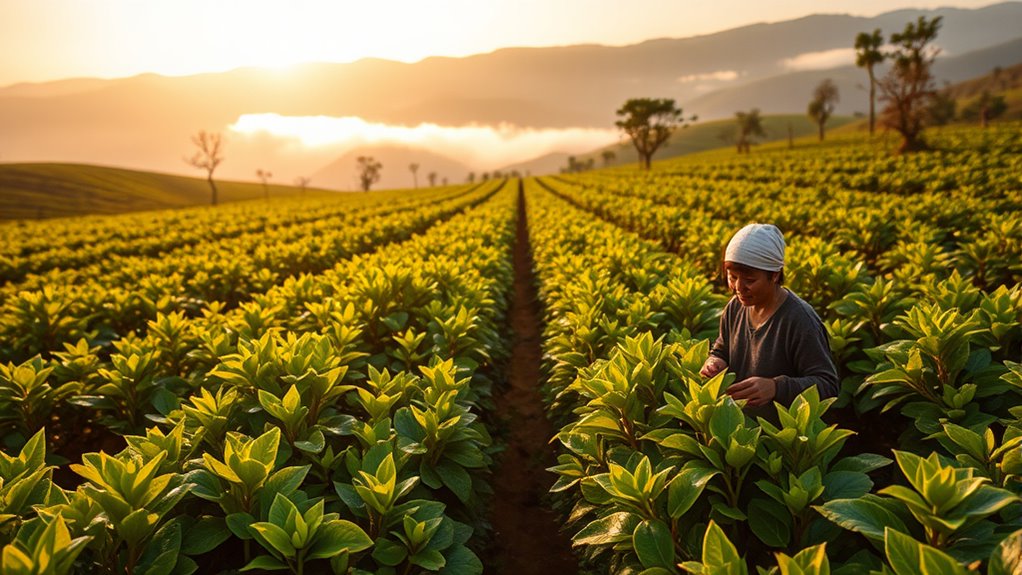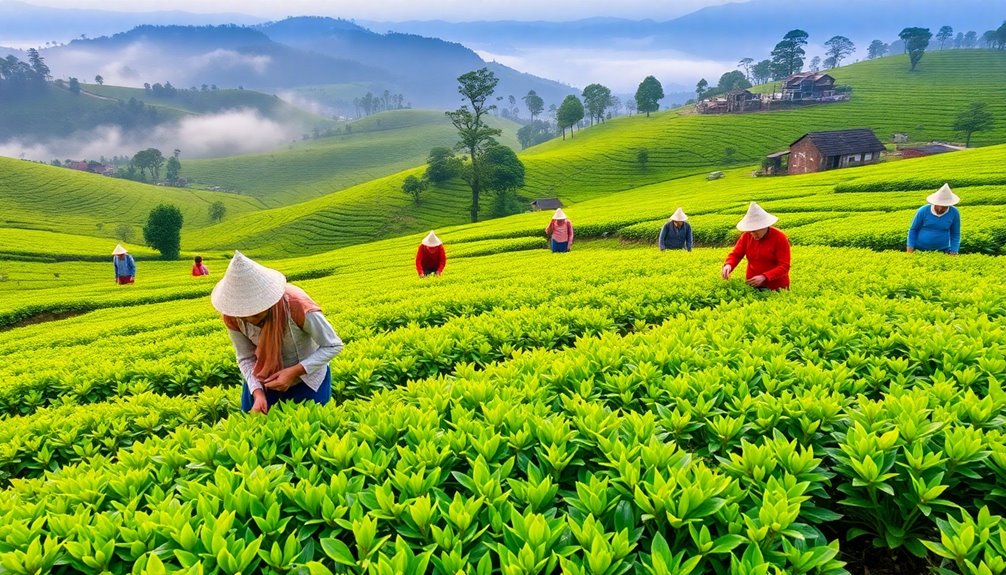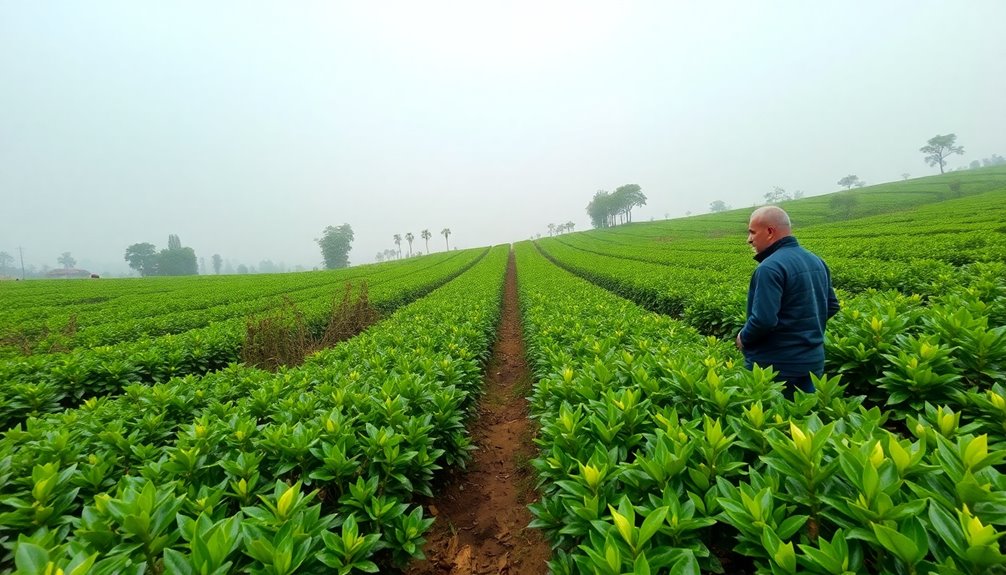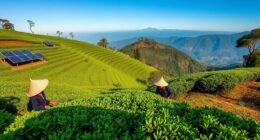Across major tea regions, harvests follow seasonal patterns influenced by local climates. In China, early spring (March-April) yields green and white teas, while later, oolongs and black teas are harvested into early summer. Assam’s peak is from late March to June, with Darjeeling harvesting from April to June. Sri Lanka sees multiple flushes from February to September, depending on altitude. Understanding these seasonal cycles helps you appreciate the flavors and qualities of your favorite teas; keep exploring to learn more.
Key Takeaways
- Tea harvesting begins in early spring (March-April) in China, with timing varying by region and climate.
- Assam’s main harvest occurs from late March to June, producing bold black teas.
- Darjeeling’s harvest spans April to June, resulting in lighter, aromatic teas due to high-altitude conditions.
- Sri Lanka experiences multiple flushes: February-April and July-September, with regional differences affecting tea profiles.
- Climate and seasonal changes directly influence harvest timing, processing methods, and the final flavor of teas.

Understanding the harvest calendar for major tea regions helps you plan your purchases and appreciate the seasonal nuances of your favorite brews. When you know when different teas are harvested, you gain insight into their flavor profiles and the unique qualities influenced by regional climate variations. This knowledge not only enhances your tasting experience but also informs your choices, whether you’re buying loose leaf or exploring new blends. The timing of the harvest directly impacts the tea’s flavor, aroma, and overall quality, making it essential to understand the seasonal cycles across key regions.
Knowing when teas are harvested enhances your tasting experience and guides smarter, seasonally informed choices.
In China, particularly in Yunnan and Fujian, the harvest usually begins in early spring, around March or April, and extends into late spring or early summer. During this period, the climate is cool and moist, which influences the tea processing methods used. For example, delicate green teas and white teas are often harvested early to preserve their freshness, while later harvests might produce more robust oolongs or black teas. The regional climate variations—such as temperature, rainfall, and humidity—play a vital role in determining not just when the teas are picked but also how they’re processed. Cooler, wetter conditions tend to favor gentle, minimal oxidation processes, like steaming or light pan-firing, to highlight the tea’s natural freshness.
Moving to India, the Assam and Darjeeling regions experience distinct harvest seasons that reflect their diverse climates. Assam’s harvest peaks from late March to June, coinciding with its humid, tropical climate, which produces bold, malty black teas ideal for breakfast blends. Darjeeling, situated at higher elevations, has a slightly later harvest window, from late spring to early summer (April to June), with cooler temperatures and mountain mist that give Darjeeling teas their characteristic floral and muscatel notes. The regional climate variations here influence not just the timing but also the complexity of processing methods, with Darjeeling teas often undergo light oxidation to preserve their delicate aroma.
In Sri Lanka, the harvest occurs in multiple flushes—mainly in February to April and again from July to September—depending on the altitude and regional climate. Low-altitude regions like Ruhuna produce stronger, full-bodied teas, while high-altitude areas like Nuwara Eliya yield lighter, more aromatic teas. The climate variations across the island dictate which processing methods are suitable at each harvest, from traditional sun-drying to modern mechanized processes, affecting the final flavor profile of the teas. Additionally, the seasonal variation in climate plays a crucial role in determining the quality and characteristics of each harvest.
Frequently Asked Questions
How Does Climate Change Impact Tea Harvest Timings?
Climate change affects your tea harvest timings by causing unpredictable weather patterns and temperature shifts. You’ll notice harvests happening earlier or later than usual, which challenges traditional schedules. To guarantee quality, farmers need to focus on climate adaptation strategies, adjusting harvest timing accordingly. Staying flexible and monitoring environmental changes become essential for maintaining ideal leaf quality and sustaining your favorite teas amidst these shifting conditions.
What Are the Best Practices for Sustainable Tea Harvesting?
Like a careful gardener tending delicate blooms, you should prioritize sustainable tea harvesting. To guarantee ideal tea leaf quality and precise harvest timing, practice selective plucking, minimize chemical use, and manage water resources responsibly. These methods protect the environment and enhance flavor. By adopting eco-friendly practices, you help maintain the health of tea plants and ensure consistent, high-quality harvests for future seasons.
How Do Harvest Calendars Vary Between Organic and Conventional Teas?
You’ll notice harvest calendars differ between organic certification and conventional farming. Organic teas often have seasonal variations due to stricter practices and natural pest control, which can shift harvesting times. Conventional farming, using synthetic inputs, may have more flexible schedules. You should expect organic harvests to align closely with natural cycles, while conventional teas might be harvested sooner or later depending on market demands and farming practices.
What Equipment Is Essential for Efficient Tea Plucking?
Did you know that a skilled tea plucker can harvest up to 20 pounds of leaves per day? To do this efficiently, you need essential equipment like sharp scissors or shears, comfortable gloves, and a sturdy harvest basket. Modern harvest tool innovations include ergonomic handles and lightweight designs, making tea plucking easier. Mastering proper tea plucking techniques with the right tools guarantees a high-quality harvest while reducing fatigue.
How Do Pests and Diseases Affect the Harvest Schedule?
Pests and diseases can disrupt your harvest schedule considerably, causing delays and reducing quality. Effective pest control and disease management are vital to protect your tea plants, guaranteeing healthy growth and timely harvests. When you actively monitor for pests and diseases, you can implement targeted treatments early. This proactive approach helps maintain a consistent harvest calendar, preserves your crop’s health, and guarantees you deliver high-quality tea to your customers.
Conclusion
Now that you know the harvest calendars, imagine what’s coming next—the teas that will soon fill your cup. From lush plantations to your hands, these rhythms shape every sip you enjoy. But the journey doesn’t end here; as seasons change, new flavors emerge, waiting to surprise you. Keep an eye on the calendar, because the next harvest could bring a fresh twist to your favorite brew. The world of tea is always evolving—are you ready to discover what’s next?










